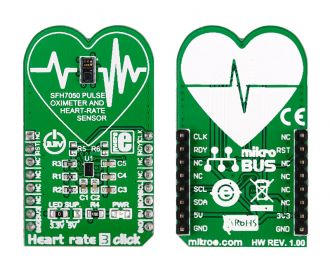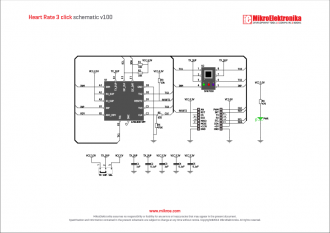
We strongly encourage users to use Package manager for sharing their code on Libstock website, because it boosts your efficiency and leaves the end user with no room for error. [more info]

Rating:
Author: MIKROE
Last Updated: 2019-07-30
Package Version: 1.0.0.1
mikroSDK Library: 1.0.0.0
Category: Biometrics
Downloaded: 6659 times
Not followed.
License: MIT license
Heart rate 3 click is a mikroBUS add-on board whose functionality is determined by two components: an OSRAM’s SFH7050 pulse oximetry and heart rate monitoring module, and a TI AFE4404 (analong-front-end) IC specialized for bio-sensing.
Do you want to subscribe in order to receive notifications regarding "Heart rate 3 click" changes.
Do you want to unsubscribe in order to stop receiving notifications regarding "Heart rate 3 click" changes.
Do you want to report abuse regarding "Heart rate 3 click".

Front and back pictures of Heart rate 3 click.
View full imageLibrary Description
The library covers all the necessary functions that enables the usage of the Heart rate 4 Click board. It initializes and defines the I2C bus driver and drivers that offer a choice for writing and reading and setting a new value.
Key functions:
void heartrate3_defaultConfig() - Function is used to apply the default configuration.uint32_t heartrate3_readLed2ValReg() - Function is used to read from LED2VAL register.uint32_t heartrate3_readAled2ValReg() - Function is used to read from ALED2VAL register.Examples description
The application is composed of three sections :
void applicationTask()
{
led2Val = heartrate3_readLed2ValReg();
LongToStr( led2Val, logTxt );
mikrobus_logWrite( logTxt, _LOG_LINE );
aled2Val = heartrate3_readAled2ValReg();
LongToStr( aled2Val, logTxt );
mikrobus_logWrite( logTxt, _LOG_LINE );
led1Val = heartrate3_readLed1ValReg();
LongToStr( led1Val, logTxt );
mikrobus_logWrite( logTxt, _LOG_LINE );
aled1Val = heartrate3_readAled1ValReg();
LongToStr( aled1Val, logTxt );
mikrobus_logWrite( logTxt, _LOG_LINE );
led2Aled2Val = heartrate3_readLed2Aled2ValReg();
LongToStr( led2Aled2Val, logTxt );
mikrobus_logWrite( logTxt, _LOG_LINE );
led1Aled1Val = heartrate3_readLed1Aled1ValReg();
LongToStr( led1Aled1Val, logTxt );
mikrobus_logWrite( logTxt, _LOG_LINE );
mikrobus_logWrite( "----------------------", _LOG_LINE );
Delay_ms( 100 );
}
Other mikroE Libraries used in the example:
Additional notes and informations
Depending on the development board you are using, you may need USB UART click, USB UART 2 click or RS232 click to connect to your PC, for development systems with no UART to USB interface available on the board. The terminal available in all MikroElektronika compilers, or any other terminal application of your choice, can be used to read the message.
